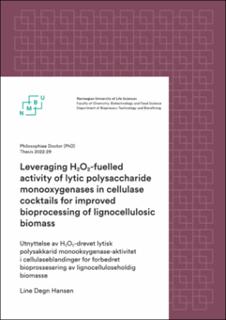| dc.contributor.advisor | Várnai, Anikó | |
| dc.contributor.advisor | Horn, Svein Jarle | |
| dc.contributor.advisor | Eijsink, Vincent | |
| dc.contributor.author | Hansen, Line Degn | |
| dc.date.accessioned | 2023-04-12T12:00:56Z | |
| dc.date.available | 2023-04-12T12:00:56Z | |
| dc.date.issued | 2022 | |
| dc.identifier.isbn | 978-82-575-1902-5 | |
| dc.identifier.issn | 1894-6402 | |
| dc.identifier.uri | https://hdl.handle.net/11250/3062666 | |
| dc.description.abstract | Rapid action is critical to reduce anthropogenic CO2 emissions in order to reach climate targets. Fossil fuel use in high emission sectors like the energy and chemical industry should therefore be reduced and replaced by sustainable alternatives. Lignocellulosic biomass, like Norwegian spruce, has potential to replace commonly used feedstocks like corn and sugarcane in a biorefinery for production of biofuels and bio-based chemicals due to its high abundance, high proportion of polysaccharides, and limited competition for arable land. Lignocellulose is a highly recalcitrant feedstock that requires high severity pretreatment and enzyme loads to produce fermentable sugars. The inclusion of lytic polysaccharide monooxygenase (LPMO) to cellulase cocktails has previously been shown to enhance saccharification yields considerably. Recent findings that LPMO activity is driven by H2O2 opens the door to novel process setups to fully harness this potential. The aim of this thesis was to improve the conversion of lignocellulosic biomass by altering process conditions to maximize the impact of LPMOs in saccharification and fermentation processes.
In Paper 1, recent developments within enzymatic processing of lignocellulosic biomass are summarized, and we show the interconnectedness between pretreatment and saccharification, and how this affects LPMOs in the cellulase cocktail. The implications of direct addition of H2O2 compared to in-situ generation is discussed in relation to choice of feedstock and process design.
The results in Paper 2 demonstrate how negative impacts from residual lignin in the saccharification step can be alleviated by inclusion of the carbocation scavenger 2-naphthol in a steam explosion pretreatment. Lignin resulting from 2-naphthol-impregnated samples improved LPMO activity not only in the cellulase cocktail but also of the chitin-active LPMO CBP21 (SmAA10A), showing that more H2O2 could be generated in the presence of impregnated lignin. This paper also explores a potential combination of biochemical (i.e., enzymatic saccharification) and thermochemical (i.e., pyrolysis) conversion steps for a softwood-based biorefinery. Impregnation had no negative impacts on bio-oil produced by pyrolysis.
In Paper 3, direct addition of H2O2 to separate hydrolysis and fermentation (SHF) and simultaneous saccharification and fermentation (SSF) processes was used to boost LPMO activity in a commercial enzyme cocktail. Production of lactic acid by B. coagulans in an SSF setup was found to be competitive with the SHF process in this study contrary to previous findings. In particular, feeding H2O2 during SSF enabled oxidative cellulose depolymerization by LPMOs present in a cellulase cocktail under anaerobic conditions.
Overall, the findings presented in this thesis illustrate how latent potential of LPMOs in commercial cellulase cocktails can be utilized to improve existing saccharification and fermentation processes. This is particularly relevant for bioprocessing of recalcitrant lignocellulosic feedstocks like the softwood Norway spruce. | en_US |
| dc.description.abstract | For å redusere menneskeskapte CO2-utslipp og for å nå klimamålene er det avgjørende å handle raskt. Bruk
av fossilt brensel i høyutslippssektorer som energi- ogkjemisk industri bør derfor reduseres og erstattes av bærekraftige alternativer. Lignocelluloseholdig biomasse, som for eksempel norsk gran, kan potensielt erstatte vanlig brukte råvarer som mais og sukkerrør i et bioraffineri for produksjon av biodrivstoff og biobaserte kjemikalier på grunn av den finnes i store mengder, har høyt innhold polysakkarider og i liten grad konkurrerer om dyrkbar jord. Lignocellulose er et svært gjenstridig råmateriale som krever intens forbehandling og høy enzymbelastning for å produsere fermenterbare sukker. Å inkludere lytisk polysakkarid monooksygenaser (LPMOer) i cellulaseblandinger har tidligere vist seg å øke sukkerutbyttet betraktelig. Nye oppdagelser som viser at LPMO-aktivitet er drevet av H2O2 muliggjør nye prosessoppsett som kan utnytte dette potensialet fullt ut. Målet med denne oppgaven var å forbedre omdannelsen av lignocelluloseholdig biomasse ved å endre prosessforhold for å maksimere virkningen av LPMO i sukkerfrigjørings- og fermenteringsprosesser. | en_US |
| dc.language.iso | eng | en_US |
| dc.publisher | Norwegian University of Life Sciences, Ås | en_US |
| dc.relation.ispartofseries | PhD Thesis;2022:29 | |
| dc.rights | Attribution-NonCommercial-NoDerivatives 4.0 Internasjonal | * |
| dc.rights.uri | http://creativecommons.org/licenses/by-nc-nd/4.0/deed.no | * |
| dc.subject | Hydrogen peroxide | en_US |
| dc.subject | LPMO | en_US |
| dc.subject | Biomass | en_US |
| dc.subject | Cellulase cocktails | en_US |
| dc.subject | Steam explosion | en_US |
| dc.subject | SSF | en_US |
| dc.subject | SHF | en_US |
| dc.subject | Lactic acid | en_US |
| dc.subject | 2-naphthol | en_US |
| dc.subject | Norway spruce | en_US |
| dc.title | Leveraging H2O2-fuelled activity of lytic polysaccharide monooxygenases in cellulase cocktails for improved bioprocessing of lignocellulosic biomass | en_US |
| dc.title.alternative | Utnyttelse av H2O2-drevet lytisk polysakkarid monooksygenase-aktivitet i cellulaseblandinger for forbedret bioprossesering av lignocelluloseholdig biomasse | en_US |
| dc.type | Doctoral thesis | en_US |
| dc.relation.project | Norges forskningsråd: 257622 | en_US |

